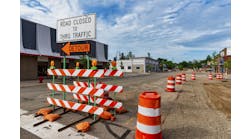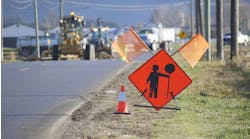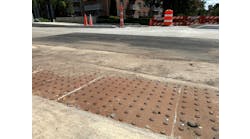Transportation professionals play an important role in shaping the past, present and future of communities. The transportation network should connect people to jobs, education, opportunities and to each other. As keepers of the transportation network, we have a responsibility to the public because we wield the power to change the course of a community. We inherited a transportation network that reflects the decision-making by our predecessors who ceded communities to motor vehicles and used transportation as a means to divide communities. Today, like professionals of the past, we find ourselves making decisions that will impact future generations. We stand at a crossroads: We have a 20th-century transportation network that needs to be redesigned to address the future needs of the 21st century. We are faced with a choice to continue following the examples set by our predecessors, or to shift the paradigm to right historical injustices by designing a network that is inclusive of all people while also preparing for the future.
The American Dream led to widening our roads
Every year the National Complete Streets Coalition puts out Dangerous by Design, which highlights trends in fatalities and serious injuries around the country. In 2019, they found “while traffic deaths impact every community in the United States, states and metropolitan areas across the southern continental United States, older adults, people of color, and people walking in low-income communities bear a higher share of this harm.” The disproportionate impacts to people of color and low-income communities are remnants of how transportation professionals design the highway systems and our roads. To understand how this came to be, it starts with the American Dream.
In 1931, James Truslow Adams described the American Dream as “life should be better and richer and fuller for everyone, with opportunity for reach according to ability or achievement.” It is a great vision that uplifts self-evident truths in the Declaration of Independence that “all men are created equal.” However, as our country was only 66 years past the abolishment of slavery and in the middle of the Jim Crow era where laws were enacted to intentionally disenfranchise black people, the American Dream was never intended for all Americans. A simple internet search of “American Dream Ads” reveals pages of ads depicting white families comprised of mom, dad, son, daughter and a dog in their personal vehicle or standing in front of their new home with a white picket fence.
The American Dream included Levittown-like communities funded in part by the federal government; however, coupled with systemic racism through Jim Crow laws, redlining and protected covenants, non-white people were locked out of the dream. As the investment of suburban communities continued, the 1950s and 1960s saw the largest migration of white families out of urban areas into rapidly growing suburban and exurban areas. With the mass migration came increased car ownership, the decline of public transportation throughout most of the country and eventually the introduction of traffic congestion as people from the suburbs still needed to commute to their jobs that remained in the urban areas.
Transportation professionals, which at that time were all white men, were given the responsibility and power to develop plans to improve traffic flow as well as building the national highway system. Operating within a climate of systemic racism and growing hostility around the country as the Civil Rights Movement was in progress, the transportation professionals designed and constructed highways and large streets through the middle of communities that were largely black and/or low-income. Still evident today, this resulted in racial segregation, air pollution, increased traffic crashes and fatalities, and adverse health in non-white communities and low-income communities.
Tools for transportation justice
Since the 1960s, our country enacted several laws and regulations to protect people from discrimination on the basis of race, color and national origin. Despite those laws, people of color and low-income communities are still disproportionately negatively impacted by the transportation network. Now, we have two additional tools that can help us change the paradigm to create an equitable, just and inclusive transportation system for the future.
If you have attended a transportation conference in the last few years you have heard talk of complete streets or Vision Zero, likely both. Complete streets are “designed and operated to enable safe access for all users, including pedestrians, bicyclists, motorists, and transit riders of all ages and abilities.” Vision Zero is a concept that originated in Sweden that is “a strategy to eliminate all traffic fatalities and severe injuries while increasing safe, healthy, equitable mobility for all.” On their own they are statements or a plan with pretty pictures. However, if we as transportation professionals build our new paradigm with these two concepts as our foundation, they both could lead to “justice,” and taking the steps to right historical design decisions, policies, and disinvestment that led to a higher number of non-white and low-income communities being disproportionately impacted by the transportation network.
While “equity versus equality” has been the focus of equity talks over the last few years, Dr. Setha Low, a professor in environmental psychology and director of the Public Space Research Group at the City University of New York, provides a framework for measuring justice within public spaces. Equality means everyone is equal and thus gets the same. Equity means everyone gets what they need, which means people who need more receive more. However, justice forces us to examine our history, decision-making, profession, and ourselves as we navigate a country still divided by race and class. While Dr. Low is referring to public parks, our transportation system is the largest public space in any city, county and state in the U.S. Three pillars of justice in her framework are Distributive, Interactional and Procedural.
In Philadelphia, benches were installed around trees lining the avenues to offer places of rest and respite for people on hot or inclement days.
Distributive justice
“In terms of public space, distributive justice based on equity would ensure that public space was available to all people and that everyone would have some degree of access.” —Dr. Low
Distributive justice is how equity is often examined. Transportation professionals may conduct a demographic analysis of the community and determine where to allocate resources to improve safety. While there may be studies and projects in those communities, a tension that transportation professionals face is being able to make drastic and lasting change by reallocating space used by cars for storage (on-street parking) or travel to other modes that can carry more people. Transportation networks that provide people no option except for single-car occupancy continue to perpetuate unjust and disproportionate impacts on low-income communities.
One challenge is the level of service (LOS) metric that reduces our roadway to grades (like in high school) with an ‘A’ being excellent and ‘F’ being a fail. To improve the LOS, transportation professionals can increase the capacity or reduce the volume on a roadway. Historically, the default has been to increase the capacity at the expense of people of color and low-income communities. Today, it leaves us with eight-lane or larger roads through suburban and urban areas, traffic signals that barely provide people walking time to get across the street, or mega-blocks that require a pedestrian to go over a half-mile out of their way to get to a signalized intersection.
A better metric for decision making is determining how many people can safely move through the corridor and evaluating the trade-off using a lane to store vehicles versus using it to move people by biking, walking, or public transit. In addition, as communities embrace Vision Zero, it requires transportation professionals to draw a line in the sand to state that safety is paramount, and we are willing to remove parking, reduce the number of vehicle lanes and lane widths, remove highway infrastructure to reconnect the grid, and/or change the signal timing to ensure safety. Considering that data shows people of color and low-income communities are disproportionately impacted, it also requires us to confront historical and current tensions around race and class. A new way of thinking could lead to a better distribution of our public right-of-way (ROW) allowing more space for people including public transit, bicycle infrastructure and wider sidewalks. Also, it requires us as professionals to be bold, brave and steadfast as we develop designs to make the streets better.
Interactional justice
“In terms of public space, interactional justice is reflected in whether people are being treated in a discriminatory way, or whether they are targets of harassment, insults, or other rude behavior.” —Dr. Low
Many transportation professionals may think our only responsibility is the planning and design of the public right-of-way (ROW). Often, we are involved in policy decisions about how the ROW is managed and enforced. This is everything from who gets to use the curbside to a new focus on enforcement under the guise of Vision Zero. However, these policies can have unintended consequences for historically marginalized communities. We become vocal on the results and silent on the impacts.
For example, “jaywalking,” a term once promoted by the automobile industry, is a law that came about to regulate pedestrians who once ruled the streets. Now it is generally not enforced until it is enforced. In the “Walking While Black” series in ProPublica, the authors found that pedestrian tickets in Jacksonville, Fla., were “disproportionately issued to blacks, almost all of them in the city’s poorest neighborhoods.” The inequitable enforcement of policies has many advocates shunning Vision Zero and its purpose. Transportation professionals must consider all users and ensure that transportation policies are not exacerbating discrimination, leading to fines and potential loss of life.
Procedural justice
“Procedural justice refers to the way that the process of negotiation and decision-making influence perceived fairness by individuals.” —Dr. Low
The U.S. DOT defines a principle of Environmental Justice (EJ) as the “full and fair participation by all potentially affected communities in the decision-making process.” While in principle, we host a public meeting that is open to the public, if we are hosting a public meeting in the middle of the week during the evening, people are being left out of the decision-making process. Depending on the community, you can predict who will show up, and attendees are probably not reflective of the entire community.
Procedural justice requires us to go beyond EJ and be proactive. A tried-and-true method is going to the people directly to reach a broad swath of the community. This could include setting up a table on the sidewalk, shopping mall or at a community event, going to where people worship or play, or even riding public transit. Young people are often missing from the process, despite the fact that they are among the most primary vulnerable users, as they are more likely to be walking, biking and using public transportation. Engaging them at school during lunchtime or an after-school event is a way to ensure their voices are part of the process.
Lastly, many people may believe the process is unfair or not transparent from the beginning. It is important to help the public understand the parameters of the project, what is and is not on the table for discussion, and be willing to share the data. The public engagement process is not always easy, but it is necessary.
Streets like this one in Tucson, Ariz., were not planned to accommodate all modes of travel.
Bringing it all together
As transportation professionals, we are charged with ensuring people are able to move from Point A to Point B safely and reliably. While we inherited a transportation system built on racial discrimination and a belief that moving cars is most important, it does not mean that we can continue with the same type of thinking. Even as we grapple with new technologies such as autonomous vehicles, dockless bike-share systems and scooters, we are susceptible to repeating past mistakes unless we completely shift the paradigm. In point of fact, complete streets and Vision Zero require us to think, act, and design differently.
We must:
- Make bold decisions to reallocate lanes for single-occupancy vehicles to other modes such as public transit, biking and walking.
- Champion complete streets and Vision Zero as a philosophy and a way of doing business so they become more than paper documents.
- Recognize whose voice is not being heard in the process and then being proactive and reach out to those communities. This may include increasing resources to be able to engage the community.
- Create a framework and vision that sets the ground rules for new technologies to serve all communities.
- Increase the number of women and people of color within the profession, so we may reflect the communities we serve.
Following the examples set by our predecessors is not an option. We must shift the paradigm to right historical injustices by designing a network that is inclusive of all people as we prepare for the future.



